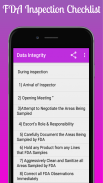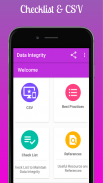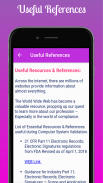










Data Integrity

Description de Data Integrity
Data Integrity is a fundamental element of a pharmaceutical industry to ensure quality and safety of drugs. Recently, the FDA and other global regulatory bodies have emphasized the importance of accurate and reliable data in assuring drug safety and quality.
This application will helpful for understanding what Data integrity really means & How 21 CFR Part 11 affects in pharmaceutical Industry.
Objectives:
1) You will get familiar with the current regulatory requirements on data integrity and how regulators refine these requirements
2) You will get a deeper understanding what FDA and other global regulatory inspectors expects from pharmaceutical companies in regard to Data Integrity
3) You will learn how to implement the (new) regulatory requirements on Data Integrity into your Pharmaceutical Quality System
4) You will learn how to prepare your company for an successful inspection in regard to Data Integrity
5) You will understand how to establish an effective Data Governance system
6) You will learn how to investigate Data Integrity issues in your company
You Will Learn:
1) Basic & Advance Concepts of Data Integrity
2) Computer System Validation Tips,
3) Mock Inspection Question & Answer
4) Checklist for Inspection
5) Industry Best Practices to Maintain Data Integrity
6) Useful Reference & Resources
7) Current Regulatory thinking on Data Integrity
8) SOP
9) Interview Q & A
10) And much, much more…
Who Will Benefit:
1) Pharmaceutical/ Medical device / Healthcare/Life science Industry personnel
2) Validation/ IT Service Providers
3) Developers of software for use in Life Sciences industry
4) Regulatory Affairs, Quality Unit
5) Laboratory personnel
6) Clinical Trial Sponsors
App Content:
Basics:-
1 Data
2 Raw Data
3 Meta Data
4 Transient Data
5 Recording of Data
6 Data Capture/Recording
7 Data Integrity
8 The Principles of Data Integrity
9 Data Lifecycle
10 Data Transfer/Migration
11 Data Processing
12 Data Governance
13 General Data Integrity observation
14 Root Cause of DI
15 Electronic Record
16 Requirements for Electronic Records
17 Electronic Signature
18 Requirements for Electronic Signature
19 Handwritten Signature:
20 Static & Dynamic Record
21 Data Review & Approval
22 Review of Electronic Data
23 Computer System
24 Computerized System Access and Security
25 History of CSV
26 Computer System Validation
27 Software
28 Category of Software
29 Software Requirement & Specification
30 Legacy Systems
31 Open System:
32 Closed System
33 Hybrid System
34 Audit Trail
35 Documentation & Records
36 Original Record
37 True Copy
38 Data Backup & Restore
39 Storage, Archival and Disposal of Electronic Data
40 Archive
41 SOP
42 Personnel Training
Advance :-
1 What is GDPR
2 New FDA Validation Approach CSV to CSA
3 User Requirement Specification
4 GAP Assessment
5 Bridging the GAP
6 Risk Assessment
7 GxP Assets Management
8 GxP Assessment
9 Vendor Assessment
10 Change management
11 Benefits of change control system
12 Deviation
13 Incident
14 CAPA
15 Validation
16 Validation protocol
17 Software Validation
18 Benefits of Software Validation
19 Software Verification:
20 Traceability Matrix
21 Equipment Log management
22 Software Life Cycle Activities
23 Qualification
24 Calibration:
25 Periodic System Evaluation
26 Retirement & Decommissioning Process
27 General Data integrity Observation
Inspection:-
1 Introduction
2 Types of inspection
3 Preparing For Inspections
4 Inspection strategies
5 Mock Inspection
6 Inspection Agenda
7 New Approach of Inspection
8 FDA (Inspectors) Expectations
9 What is QSIT (Quality System Inspection Technique)
10 QSIT Management controls
11 QSIT Design Controls
12 QSIT CAPA Controls
13 QSIT Production and Process Controls
14 Do’s and Don’ts Inspection
15 Setting up the team for Inspection
16 Objective of Inspection
17 WARNING LETTERS
18 FROM 483
19 Whistle-Blowing, The Next Big Wave
All the Best for Better Compliance.
Team Innovative Appz





















